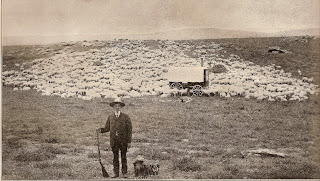Sheep herding on the open prairie
This photograph is from my 1922 world geography book. The man is a sheep herder in Montana. It must have been an exciting day for him when this photograph was made. He appears to be dressed in his best suit of clothing for the occasion. The two little dogs beside him don't look much like "sheep dogs", but I'm sure he had trained them to help.
Here's the description the book gives of sheep ranching and the sheep herder's life:
A good sized sheep ranch has from twenty-five thousand to forty thousand herd of sheep. These, like cattle, may feed partly upon government land, or the "range" and partly open land fenced in and owned by the ranchman. During the coldest winter weather, when the snow may be so deep that the sheep cannot obtain food, they are often driven into protected corrals and fed on alfalfa. The fierce winds of the open plains help them, however, by drifting the snow and thus leaving open patches where they can find grass.
When the sheep are feeding on the range, one man, with a dog can herd twenty-five hundred; and if he has a horse to ride, he sometimes takes care of five thousand Selecting a spot near water for a camp, the herder drives his sheep out each morning, and back at night, going each day a distance of two or three miles from camp. When the grass is eaten in one place, the camp is moved; then from the new point as a center, they wander out as before.
The life of the herder is extremely lonely, both day and night being spent with the sheep. Once a week a man brings him food; and for weeks, and even months at a time, the only company he has aside from his sheep, is his dog and possibly his horse.
Source: World Geographies: Second Book by Ralph S. Tarr, B.S. F.G.S.A, and Frank M. McMurry, Ph. D. Copyrighted in 1920 and published in New York by the Macmillan Company in 1922.
The article says that one out of twenty sheep died during the harsh Montana winter. These animals were skinned and the hides were sent to market in early spring.
About the first of June, the sheep were sheared. To avoid the expense of transporting the wool, the sheep were often driven to the railroad over a period of weeks. They grazed along the way, moving a few miles closer to their destination each day. When they arrived at the railhead, they were sheared. The wool was pressed into bales and shipped to the eastern U.S. for manufacturing.
According to the book, some 3 to 5 year-old sheep were sold for mutton starting in July. I suppose that by mid-summer, they had regained some fat.

9 comments:
My cousin maintains a B&B on the family ranch in northwestern NE (south of Chadron) using his collection of antique sheep wagons, which people can rent for a weekend to experience the outdoors: http://www.sheepwagonhideouts.com/
Hi, Runaway. I'm glad your shoulder is doing well enough that you can type. :)
One of my dad's uncles (a brother to my grandfather) had a sheep ranch in Wyoming. I think it was supposed to have been in the Buffalo, Wyoming, area, but I'm not too clear on that. I think my generation has mostly lost touch with that branch of the family tree.
As a sheepherder who herded in the high country of Montana just north of Yellowstone Park in my younger days, and a sheep shearer who has traveled all over Montana and even into Wyoming... some of your facts need to be... looked at... I have never seen or heard of a ranch with 40,000 head of sheep.... most were the average band size of 2500. One ranch however boasted of 300,000 head.... was The Bair ranch in Martinsdale, Montana. It is now a museum. www.bairfamilymuseum.org/legacy.htm
Sheepherding is not romantic or religiously pure... it's just hard work.
Dave
Thanks for your comment, Dave. I didn't invent the statistics in this post. It's directly quoted from the old textbook that I cited in the post. It may or may not be accurate, but that's what the owners of this book were learning in the 1920s.
During the early 60's, fresh off a Sandhills CATTLE ranch, I was working as a police officer in Scottsbluff. One hot August day I had to search for a fugitive in a railroad warehouse full of green sheep hides. Fifty years later the mere sight of all those wollies in this picture makes my nose twitch.
The breadth of the subjects in your postings is also breathtaking....but in a much nicer way....Happy New Year.
Happy New Year to you, Friend. I must confess -- subjects vary widely in this blog because it lacks a clearly-defined theme. :D
When you say "green sheep hides". I'm thinking you mean uncured. Ugh!
Thanks for letting me comment on your site. My Father and Mother we sheepherders in Eastern Montana and Western South Dakota during this time. They herded sheep out of Ekalaka and Alzada and raised a family in 2 sheet wagons on the rolling hills (North of the Black Hills) of Montana and Western South Dakota. I am completing a novel on his life and will be in Eastern Montana doing research in the next couple of months. I enjoyed reading your blog from your 1922 geography book. Very accurate ideas (size of herd, dogs, horse, etc.) according to my Dad. JD Stone,Ph.D.
That is a truly unique setting for a novel, and you are surely uniquely qualified to write it. I hope your research goes well and that the writing flows. Thanks for stopping by.
My great grandfather was a sheep herder in Wyoming. He met my great grandmother bc her father was a local butcher. When they married, they spent their wedding night in his sheep herding wagon.
Post a Comment